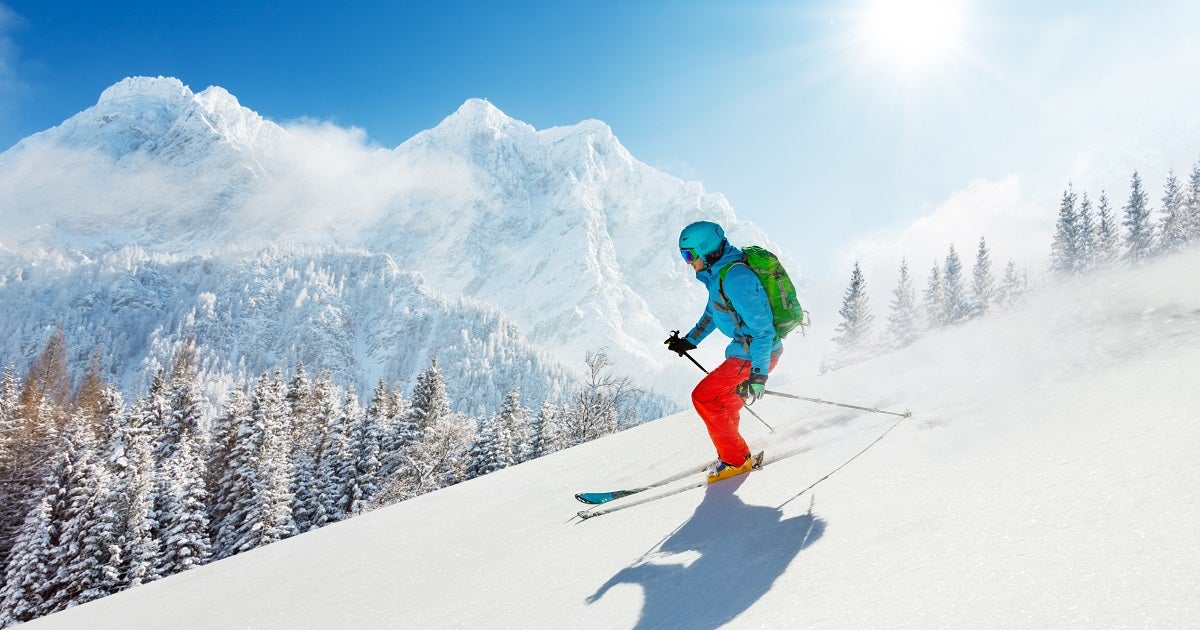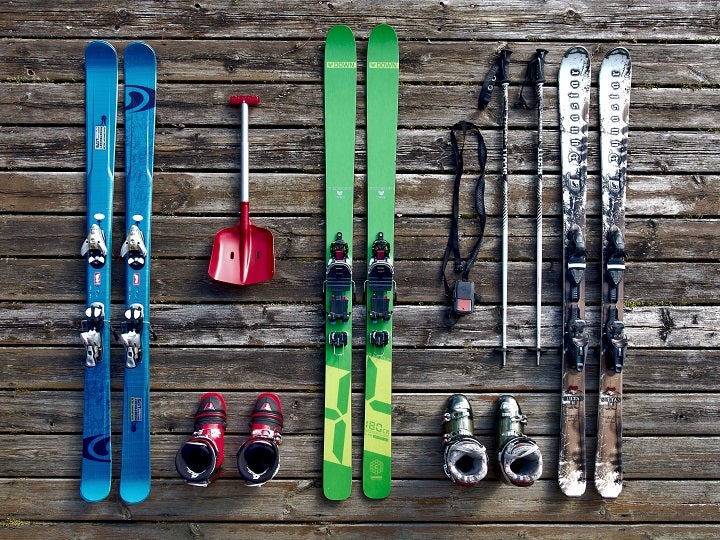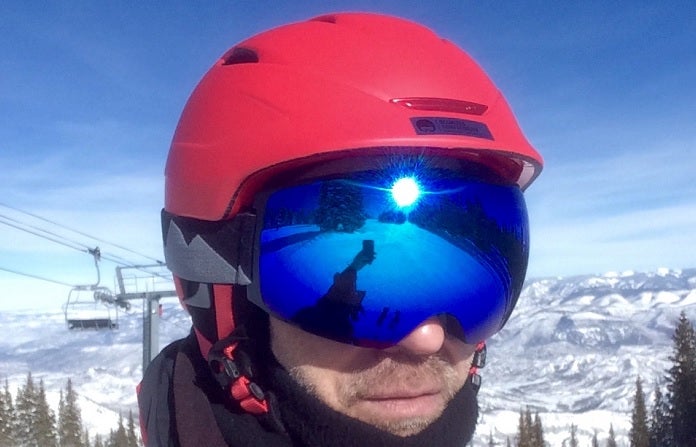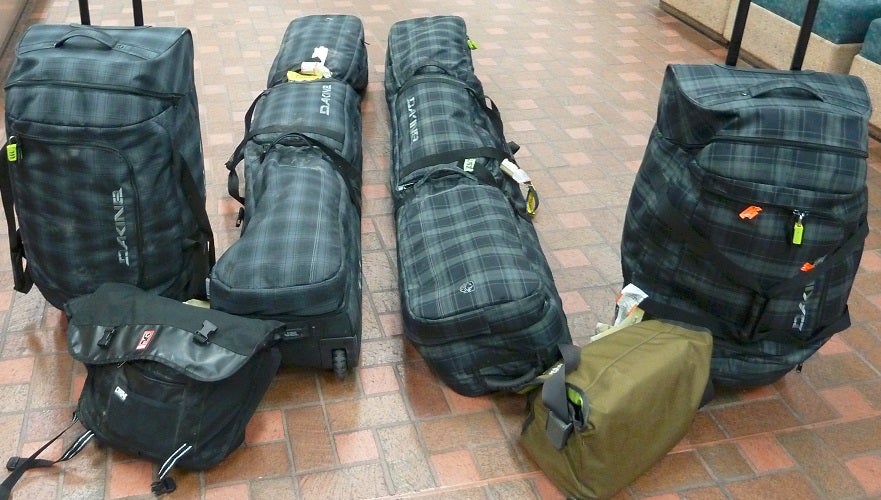
Our Editors independently research, test, and rate what we feel are the best products. We use affiliate links and may receive a small commission on purchases.
Winter is coming, as Ned Stark would say. What does that mean for the outdoor sports world? It means alpine skiing is about to kick off for the season and you had better get out there!
If you’ve never learned to ski then you’re missing out on some serious fun! It’s a great family sport and wonderfully enjoyable regardless of your skill level. Remember, if you’re not having fun – you’re doing it wrong.
Getting started skiing can be overwhelming, however, so I’m going to give you the ski instructor insight to get on the slopes quick, safe, and effectively. Here we go!
Ski Equipment Basics
Skis and Boots
If you’re just getting started, you’ll want to rent for a while. It means you can fly in with just your clothing, head to the resort, and pick up your gear without hassle. Being able to rent also lets you get used to the equipment before you throw down the benjies for your own gear.
Rent a good pair of narrow shape skis. Avoid the trendy “fat skis” which, while they may look cool, are harder to learn on and useless on the groomed runs where you’ll be starting out.
Ask the rental tech to give you a shorter pair of skis than normal since you’re learning – it’s easier to control and learn on shorter skis. Once you’re a pro you can go up to a normal size set of skis for your size.
Boots are critical to good, comfortable skiing. Work with the rental tech to get a good boot fit and if you find your boots are painful or poorly fitting throughout the day – head back to rentals and ask for a change in sizing or solution to your problem.
When you are ready to buy your skis and boots, here is a guide to beginner skis, bindings and a guide to beginner ski boots.
PRO TIP: People love to shove pant cuffs into ski boots. DON’T DO IT!!!! The only thing that belongs in your ski boot is your foot and a tall sock.
Get your tights, pant legs, and snow pants out of there or you’ll get blisters, hot spots, and pain. A good pair of socks will keep your feet warm and dry, here is a guide to ski socks.
Ski Poles
Ditch the poles, they’re not useful for a beginner. Too many beginners develop bad habits by using poles when learning and it will simply hinder your learning.
If you think you “need” poles I will tell you it’s totally possible to ski without them and do so very effectively. Poles are most helpful in highly advanced level skiing where they actually are used for certain techniques and timing.
You’ll be light years ahead of other skiers if you learn to ski without poles first, then add them in later. When you are, here is a guide to ski poles.
Ski Helmets and Goggles
Always wear a helmet. If you’re going to buy one piece of gear, make it a helmet. Second piece of gear? Goggles.
It’s not necessary to buy the flashiest pair of goggles – in fact some of the most advanced technically talented skiers I know roll around in old school looking gear. Good skiing does not come from fancy gear.
I will say, however, that large lens goggles are amazing for the added viewing range and peripheral vision.
Each helmet manufacturer is slightly different in fitment so shop around before deciding and if your buy one online, make sure its returnable. Here is a guide to ski helmets and goggles. Also check out this guide to merino wool beanies.
Ski Apparel
Learn how to layer! It’s not really necessary to buy a whole new wardrobe to go skiing, you just need to have a few good layers of decent outdoor clothing.
Look for a good base layer like merino wool or polyester shirts and tights. Over that you’ll want to add an insulation layer like a fleece or puffy jacket.
Finally, you’ll want a “hard shell” such as waterproof ski pants and ski jacket. Ladies, we have you covered with how to choose women’s ski jacket and women’s ski pants. Down jackets are preferred for colder skiing weather but watch out for bulkiness.
There are unlimited variations on this but the main thing is to layer so that you can add and remove clothing throughout the day as temperatures change on the mountain. A good base layer will help keep you warm and comfortable all day.
Some general purpose base layers for cold weather are effective, but their added thickness will restrict movement when trying to ski and get to and from ski lifts.
Also, neck warmers (aka gaiters) will help tremendously with sealing cold air out. But again, be sure that movement isn’t restricted such that performance is affected.
Pro Tip: Careful washing of your ski jacket will prolong it’s life!
Ski Gloves / Mittens
Ski gloves are usually under rated by most people. They just go to the store and pick up a pair of stylish ski gloves without considering if they are truly “ski gloves”. You may find that heated gloves are effective but be sure they are not restricting finger movement and grip.
There is a difference, ski gloves are breathable and will keep your hands warm under all conditions. While they don’t need to be water proof, they definitely need to be water resistant. Here is a guide to Men’s ski gloves and Women’s ski gloves.
Pro Tip: If your hands are still cold even with a good pair of gloves, consider ski mittens. Mittens are warmer since they keep all your fingers together.
Transporting Your Equipment
While don’t advocate buying skis and boots right off the bat. When it comes time buying a good quality ski boot bag and a ski travel bag will make transporting them significantly easier.
Most travel bags allow you to keep your googles, gloves and other equipment in them freeing up space in your suitcase for your clothing.
If you plan on heading to the slopes in your vehicle, having a good ski roof rack will make transporting your skis finely easier.
Ski Lessons (get them)
Alright, first let me first say that after spending over 100 days a season teaching skiing, this is the single best thing you can do to enjoy your time on the slopes.
The first time I ever hit the slopes was with a friend and his family. I was 19. He spent about 30 minutes showing me how to use a tow rope (yeah, old school) and do the pizza wedge which I am pretty sure I just failed at.
In no time flat he declared that he’d “be back in a while” and headed up the lift. I didn’t see him again all day. The rest of my day was spent hurtling down hills and narrowly avoiding killing people (myself included).
I can’t tell you how many people I talk to or meet at the resort who have come with a friend or husband and are pushed out of their comfort zones and scared of skiing.
For whatever reason – your friends and loved ones will fail to teach you anything helpful, make you feel uncomfortable, and then pressure you into skiing terrain which is dangerous and unsafe for your skill level.
Take a lesson with an instructor because your instructor is trained to help keep you safe, and teach you so that you don’t get scared of skiing.
It’s irresponsible and silly to start skiing down slopes when you’re not in control of your speed and technique. That puts you and others at serious risk of injury so at least learn from an instructor until you’re able to control your speed, stop, and turn comfortably. Then go learn on your own if you wish!
Skills to Master Before Leaving the Beginner Hill
Explaining the following skills in detail is beyond the scope of this article but a quick google search (or ski instructor) should provide the details. Don’t let anyone convince you to move off the beginner hill until you’ve mastered the following skills:
Straight Ski to Pizza Stop
Learn to slide down a very gently slope into a pizza wedge stop. Use the pizza wedge to control your speed by slowing down, speeding up, and stopping as you vary the size and shape of your “pizza”.
Side Step
Walking foot-to-foot sideways up the hill is called a “side step” it’s a critical skill to master before you need the skill. This skill is critical to getting yourself up and out of areas if you’ve fallen or need to move in a certain direction which is not downhill. There are other uses for this skill later.
Herringbone and Skating
Almost the inverse of a “pizza wedge” is the herringbone where the tips of your skis are pointing outward and you use the inside edge of the ski to push off and move forward.
This is a lot like ice skating or rollerblading. Once you develop this skill you can walk up the hill or skate across flat areas with good speed. This is critical for new skiers.
Wedge Change Ups
While controlling your speed, in a straight line down a very gentle hill, vary your skis from “pizza wedge” to “French fries” or wedge skiing to parallel skiing.
The goal here is to get used to switching between wedge and parallel while still controlling speed. Use the wedge to slow yourself back down between parallel skiing stints to keep your speed under control.
Wedge Christies
This is the introduction to parallel skiing! Welcome to the world of skiing, you’ve made it at this point. The goal here is to finish your wedge turn with parallel skis.
Initiate a turn in a pizza wedge while controlling your speed and then, as you progress through the turn, bring your feet together into a parallel skiing stance by the end of the turn. You should be parallel with your skis pointing across the hill.
Side Slip
Side slips are critical for speed control and the “oh crap” moment when you realize you’re scared or over your head in a situation. With your skis pointing sideways across the hill, look down the hill and flatten your skis until they begin to “slip sideways” down the hill.
The goal is to slide sideways on your skis with your toes and heels pointing perpendicular to the hill. This can be difficult to learn and master so check out some YouTube videos and talk to an instructor.
Learn the Skier’s Responsibility Code
It’s really important to learn, understand, and respect the skier’s responsibility code. Some may laugh at this idea but it will save you and others from embarrassment, injury, and issue. Here they are:
- Always stay in control, and be able to stop or avoid other people or objects.
- People ahead of you have the right of way. It is your responsibility to avoid them.
- You must not stop where you obstruct a trail, or are not visible from above.
- Whenever starting downhill or merging into a trail, look uphill and yield to others.
- Always use devices to help prevent runaway equipment.
- Observe all posted signs and warnings. Keep off closed trails and out of closed areas.
- Prior to using any lift, you must have the knowledge and ability to load, ride and unload safely.
Other skiers will expect you to know this and you’ll notice when skiers are unaware of the code. For instance, if you happen to overlook number four, you’ll notice that skiers coming down the hill are pretty likely to either run you over, flip you off, or yell at you if you jump out in front of them without looking.
Pro Tip: Avoid saying “on your left” or “on your right” unless you’re on a tiny cat track. Advanced skiers and instructors will probably laugh at you or be rather upset because of rule number two where “downhill skiers have the right of way”.
There’s no way you should be passing other skiers so closely that you need to tell them where you are. It’s your job to go around them – not the other way around. Not only is it rude, it’s unsafe and unnecessary.
Conclusion
If you’re just getting started skiing, save money and avoid the trendy gear. Get what you need to learn and progress accordingly.
Do yourself a favor and take a few group lessons (cheaper than private lessons) to start learning the basics and stay on the beginner hill until you’ve mastered stopping, turning, and controlling your speed.
Stay safe out there and make sure to enjoy yourself or you’re probably doing it wrong!
Be sure you check out my 8 Tips for First Time Skiers and What to Take Skiing articles. And if you want to learn more about ski clothing technology see Hi-Tech Winter Clothing Materials and Fabrics.




One Comment